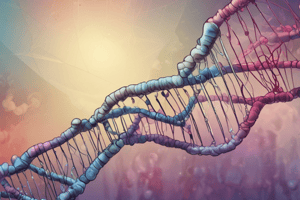Podcast
Questions and Answers
The study of heredity, genes, and genetic variation is known as the study of ______.
The study of heredity, genes, and genetic variation is known as the study of ______.
genetics
DNA is a molecule that contains ______ information.
DNA is a molecule that contains ______ information.
genetic
Each base pair in DNA is approximately ______ angstroms apart.
Each base pair in DNA is approximately ______ angstroms apart.
3.4
Segments of DNA that code for proteins or RNA molecules are called ______.
Segments of DNA that code for proteins or RNA molecules are called ______.
Thread-like structures composed of DNA and proteins are called ______.
Thread-like structures composed of DNA and proteins are called ______.
The principles of inheritance discovered by Gregor Mendel are known as ______ inheritance.
The principles of inheritance discovered by Gregor Mendel are known as ______ inheritance.
A trait that is expressed when one copy of the dominant allele is present is said to be ______ dominant.
A trait that is expressed when one copy of the dominant allele is present is said to be ______ dominant.
Genes located on the X chromosome often affecting males more severely are said to be ______-linked.
Genes located on the X chromosome often affecting males more severely are said to be ______-linked.
The process of amplifying specific DNA sequences is known as ______.
The process of amplifying specific DNA sequences is known as ______.
The process of determining the order of nucleotides in a DNA molecule is known as ______ sequencing.
The process of determining the order of nucleotides in a DNA molecule is known as ______ sequencing.
Flashcards are hidden until you start studying
Study Notes
Genetics Overview
- Study of heredity, genes, and genetic variation
- Involves the transmission of traits from one generation to the next
Key Concepts
- DNA (Deoxyribonucleic acid): molecule that contains genetic information
- Double helix structure with sugar-phosphate backbone and nitrogenous bases (A, C, G, T)
- Each base pair is 3.4 angstroms apart
- Genes: segments of DNA that code for proteins or RNA molecules
- Consist of exons (coding regions) and introns (non-coding regions)
- Chromosomes: thread-like structures composed of DNA and proteins
- Humans have 23 pairs (46 total) of chromosomes
Inheritance Patterns
- Mendelian Inheritance: principles of inheritance discovered by Gregor Mendel
- Law of Segregation: each pair of alleles separates during gamete formation
- Law of Independent Assortment: alleles for different genes are sorted independently
- Autosomal Dominant: one copy of the dominant allele is enough to express the trait
- Autosomal Recessive: two copies of the recessive allele are needed to express the trait
- X-Linked: genes located on the X chromosome, often affecting males more severely
Genetic Variation
- Mutations: changes in DNA sequence
- Point mutations: single nucleotide change
- Frameshift mutations: insertion or deletion of nucleotides
- Genetic Drift: random events that change allele frequencies in a population
- Gene Flow: movement of genes from one population to another
- Natural Selection: differential reproduction based on variation in traits
Genetic Tools and Techniques
- PCR (Polymerase Chain Reaction): amplifies specific DNA sequences
- DNA Sequencing: determines the order of nucleotides in a DNA molecule
- Genetic Engineering: modification of an organism's genome using biotechnology
- Genetic Screening: testing for genetic disorders or mutations
Genetics Overview
- Genetics is the study of heredity, genes, and genetic variation, involving the transmission of traits from one generation to the next.
DNA Structure and Function
- DNA is a double helix molecule with a sugar-phosphate backbone and nitrogenous bases (A, C, G, T) that are 3.4 angstroms apart.
- DNA contains genetic information.
Genes and Chromosomes
- Genes are segments of DNA that code for proteins or RNA molecules, consisting of exons (coding regions) and introns (non-coding regions).
- Chromosomes are thread-like structures composed of DNA and proteins, with humans having 23 pairs (46 total) of chromosomes.
Inheritance Patterns
- Mendelian Inheritance principles include the Law of Segregation, where each pair of alleles separates during gamete formation, and the Law of Independent Assortment, where alleles for different genes are sorted independently.
- Autosomal Dominant inheritance requires one copy of the dominant allele to express the trait.
- Autosomal Recessive inheritance requires two copies of the recessive allele to express the trait.
- X-Linked inheritance involves genes located on the X chromosome, often affecting males more severely.
Genetic Variation
- Mutations are changes in DNA sequence, including point mutations (single nucleotide change) and frameshift mutations (insertion or deletion of nucleotides).
- Genetic Drift occurs through random events that change allele frequencies in a population.
- Gene Flow occurs through the movement of genes from one population to another.
- Natural Selection is the process of differential reproduction based on variation in traits.
Genetic Tools and Techniques
- PCR (Polymerase Chain Reaction) amplifies specific DNA sequences.
- DNA Sequencing determines the order of nucleotides in a DNA molecule.
- Genetic Engineering involves the modification of an organism's genome using biotechnology.
- Genetic Screening involves testing for genetic disorders or mutations.
Studying That Suits You
Use AI to generate personalized quizzes and flashcards to suit your learning preferences.




